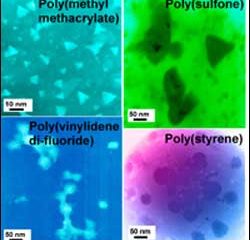Materials management deals with the research, development, manufacturing and processing of raw and industrial materials. Key aspects here are biological and medical issues, which play an increasingly important role in this field.
innovations-report offers in-depth articles related to the development and application of materials and the structure and properties of new materials.

Composite material, compression process to reduce time, cost of manufacturing bipolar plates
A single fuel cell does not produce enough energy to power a car. So fuel cells are stacked, with a bipolar plate between each cell through which electrons are conducted. The hydrogen fuel and oxygen, which are part of the fuel cell chemistry, enter the plate through channels along the face on each side of the plates. Creating the channels in the bipolar plate is a manufacturing challenge.

Controlling nanoparticle size
Because the properties of nanoparticles depend so closely on their size, size distribution and morphology, techniques for controlling the growth of these tiny structures is of great interest to materials researchers today.
A research team from the Georgia Institute of Technology and Drexel University has discovered a surprising new mechanism by which polymer materials used in nanocomposites control the growth of particles. Reported on Au

Researchers at the U.S. Department of Energy’s Argonne National Laboratory have combined the world’s hardest known material – diamond – with the world’s strongest structural form – carbon nanotubes. This new process for “growing” diamond and carbon nanotubes together opens the way for its use in a number of energy-related applications.
The technique is the first successful synthesis of a diamond-nanotube nanocomposite, which means for the first time this specialized

Supercritical fluid carbon dioxide used; melt properties provide monitor
There is a lot of excitement about incorporating nano particles into polymers because of the ability to improve various properties with only a small percent of the particles. “You can improve the barrier to gases, such as hydrogen, carbon dioxide, and oxygen. You can increase material strength with little increase in weight,” said Don Baird, professor of chemical engineering at Virginia Tech.
Bu

Performing quantum calculations on a supercomputer, scientists at Pacific Northwest National Laboratory have characterized a material that might allow on-board refueling of hydrogen powered vehicles.
Researchers, led by Maciej Gutowski, looked at different crystalline structures of a compound made up of nitrogen, boron and hydrogen – NBH6 – and found one that might be more stable compared to ammonia borane, a molecular crystal built of NH3BH3 molecules. Ammonia borane can hold

Foggy windows and lenses are a nuisance, and in the case of automobile windows, can pose a driving hazard. Now, a group of scientists at the Massachusetts Institute of Technology (MIT) may have found a permanent solution to the problem. The team has developed a unique polymer coating — made of silica nanoparticles — that they say can create surfaces that never fog.
The transparent coating can be applied to eyeglasses, camera lenses, ski goggles … even bathroom mirrors, they say.